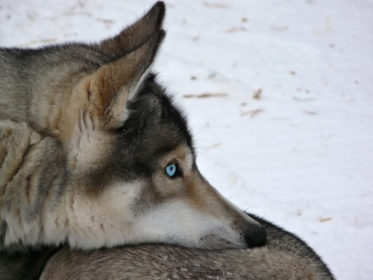
Van Morrison recorded a big hit with Brown Eyed Girl, but today we’re talking about “blue eyed dogs.”
The default eye color for dogs is brown, but if you have a certain breed, you may have blue eyed dogs whose eye color gene is independent of coat color. In other cases, however, the blue eye gene is associated with the coat being either entirely or partly white. If there is extreme white spotting, a dog might have blue eyes. If white is the prevailing head color especially around the eyes, the dog might have blue eyes. If the white head markings are uneven, the dog might have a blue eye on the side with the most white. Blue eye coloring is a recessive gene that exists in a good many breeds. Indeed, a puppy can even be born with blue eyes even though its parents don’t have blue eyes.
As an aside, we should add that in some breeds, blue eyes are a fault. They are a disqualification for the Alaskan Malamute, Cirneco dell’Etna, Bulldog, Russell Terrier, American Eskimo Dog, Bernese Mountain Dog, Dutch Shepherd, Bergamasco, Anatolian Shepherd, Boerboel, Rat Terrier, Cane Corso, Samoyed, Cardigan Welsh Corgi, Bull Terrier, Entlebucher Mountain Dog, and Boston Terrier, and it’s a severe fault in the Nederlandse Kooikerhondje and Chihuahua
In 2018, curious scientists wanted to know if there were other variations besides coat color that might cause blue eye color in dogs. They tested and studied the DNA of more than 6,070 dogs, the DNA provided by owners who had purchased DNA test kits (which also made this the largest study ever to compare dogs’ complete genetic profile) and found something interesting.
A genetic change, or mutation near a gene known as ALX4 on canine chromosome 18 was found, and it is strongly associated with blue eyes in Siberian huskies. The mutation of that ALX4 gene in Siberian Huskies seems to result in decreased pigment production in the eye. The lack of pigment causes the eye to appear blue. One of the researchers, Kristopher Irizarry said, “There’s no blue pigment. It’s about the way the light enters and exits the eye, creating the appearance of blue, the same way the sky looks blue but outer space is not blue.”
The type of mutation found in the study, the duplication of a snippet of genetic information in this case, is also how tri-colored Australian shepherds can sometimes turn up with blue eyes, something that wasn’t known or unexplained before the study.
By coincidence, we came across an article from 2018 entitled, “Why Israel Is Thronged With Blue-eyed Dogs.” Blue eyes in the Middle East are pretty rare, both in canines and people, but dogs were showing up with blue eyes. The article suggests that the recent trend of immigrating to Israel with family pets, including huskies which have become popular in Israel (the authors also shrugged their shoulders at this) may explain this. Many local dog owners aren’t as careful about their dogs’ romantic escapades as they might be, and the blue eye genetic tweak has been introduced to the local dog population.
You can read the study that was published in the journal PLOS Genetics by Adam Boyko and Aaron Sams of Embark Veterinary, Inc. here.
*Don’t It Make My Brown Eyes Blue

Whippets also have a DQ for blue eyes.
It is the Pembroke Welsh Corgi that is a disqualification for blue eyes.
Cardigirl Welsh Corgis that are blue Merle often have blue eyes.